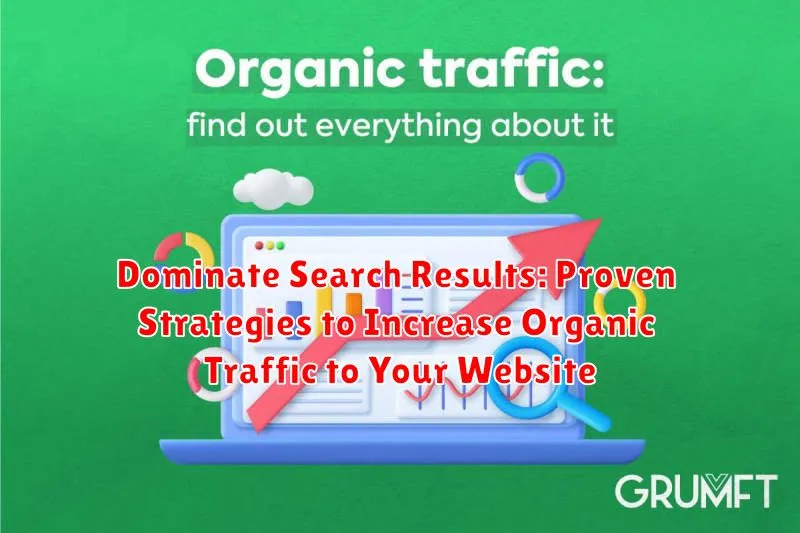In today’s digital landscape, a strong online presence is crucial for business success. Driving organic traffic to your website is a cornerstone of that presence, and achieving high rankings in search engine results pages (SERPs) is paramount. This article will delve into proven strategies to help you dominate search results and significantly increase organic traffic to your website. We’ll explore the essential elements of search engine optimization (SEO), offering actionable insights to enhance your website’s visibility and attract a larger audience.
From optimizing your website’s content and structure to building high-quality backlinks and understanding user behavior, we will cover a comprehensive range of tactics to improve your organic search rankings. Whether you’re a seasoned SEO professional or just starting your journey, this guide will provide you with the knowledge and tools necessary to dominate search results, increase organic traffic, and ultimately achieve your online marketing goals. Learn how to leverage the power of SEO to drive sustainable growth and establish a prominent online presence.
Understanding Organic Traffic and Its Importance
Organic traffic refers to the visitors that land on your website through unpaid search engine results. It’s the result of effective Search Engine Optimization (SEO), where your website earns high rankings for relevant keywords. Unlike paid traffic, organic traffic is earned, not bought.
The importance of organic traffic cannot be overstated. It provides a sustainable and cost-effective way to attract a targeted audience. Users who find your website through organic search are often actively searching for information related to your products or services, making them highly qualified leads.
Benefits of Organic Traffic:
- Higher Credibility: Users often perceive websites ranking high in organic search results as more trustworthy and authoritative.
- Long-Term Growth: Effective SEO builds a foundation for long-term, sustainable traffic growth.
- Cost-Effectiveness: While SEO requires investment, organic traffic itself is free, unlike paid advertising.
- Targeted Audience: Organic search attracts users actively looking for information related to your offerings.
Keyword Research and Optimization
Keyword research forms the foundation of any successful SEO strategy. It involves identifying the terms people use when searching for information related to your products or services.
Effective keyword research involves understanding search volume (how often a keyword is searched), keyword difficulty (how competitive it is to rank for a keyword), and relevance (how closely the keyword aligns with your content).
Several tools can assist in keyword research, including free options like Google Keyword Planner and paid tools like Ahrefs and SEMrush. These tools provide valuable data on search volume, keyword difficulty, and related keywords.
Once you’ve identified relevant keywords, optimize your content by strategically incorporating them into your page titles, headings, meta descriptions, and body text. However, avoid keyword stuffing, which is the overuse of keywords, as this can negatively impact your rankings.
Focus on using keywords naturally within your content to provide a positive user experience.
On-Page Optimization Techniques
On-page optimization focuses on elements within your website that you can directly control to improve search engine rankings and user experience. These techniques help search engines understand your content and determine its relevance to specific search queries.
Key On-Page Factors:
- Title Tags: Craft compelling and accurate title tags that incorporate relevant keywords. Keep them concise and descriptive, accurately reflecting the page’s content.
- Meta Descriptions: Write informative meta descriptions that entice users to click through from search results. While not a direct ranking factor, they influence click-through rates, indirectly impacting organic traffic.
- Header Tags (H1-H6): Structure your content using header tags to create a clear hierarchy and highlight key information. Use your primary keyword in the H1 tag and related keywords in subsequent headings.
- Image Optimization: Use descriptive alt text for all images to help search engines understand their content and improve accessibility. Compress images to optimize page load speed.
- URL Optimization: Create short, descriptive URLs that include relevant keywords. Avoid using complex characters or unnecessary parameters.
- Content Optimization: Ensure your content is high-quality, relevant, and engaging. Use keywords naturally throughout the text, focusing on providing valuable information to users.
Content Marketing Strategies for Organic Traffic Growth
Content marketing plays a crucial role in attracting and retaining organic traffic. By creating high-quality, valuable content, you can establish your website as a trusted resource and improve search engine rankings.
Developing a Content Strategy
A well-defined content strategy is essential. This involves understanding your target audience, identifying their needs and pain points, and creating content that addresses those needs.
Content Formats for Organic Growth
- Blog Posts: Provide in-depth information on relevant topics.
- Infographics: Present data visually for easy comprehension.
- Videos: Engage users with dynamic content.
- Case Studies: Showcase successful applications of your products or services.
Consistency is key. Regularly publishing fresh, engaging content keeps your audience coming back and signals search engines that your website is active and relevant.
Link Building Strategies for SEO
Link building remains a crucial aspect of SEO, influencing how search engines perceive your website’s authority and relevance. A robust link building strategy focuses on acquiring high-quality backlinks from reputable sources.
Several effective link building strategies can significantly boost your website’s organic traffic. Guest blogging on relevant industry websites allows you to reach a wider audience and secure valuable backlinks. Broken link building involves identifying broken links on other websites and suggesting your content as a replacement. Outreach to influencers and journalists within your niche can generate backlinks from authoritative sources.
Directory submissions, although less impactful than before, can still provide beneficial backlinks, especially for local businesses. Participating in relevant online communities and forums also presents opportunities for link building. Remember to prioritize quality over quantity; a few high-quality backlinks from authoritative sources are more valuable than numerous low-quality links.
Technical SEO Best Practices
Technical SEO focuses on optimizing your website’s infrastructure for search engines. This encompasses several crucial elements that directly impact your site’s visibility and ranking.
Website Speed is paramount. A slow-loading website leads to a poor user experience and negatively affects search rankings. Optimize images, leverage browser caching, and minimize HTTP requests to improve load times.
A properly configured XML Sitemap allows search engines to easily crawl and index your website’s pages. Ensure your sitemap is up-to-date and accurately reflects your site’s structure.
Mobile-Friendliness is no longer optional. With the majority of searches happening on mobile devices, a responsive design is essential for optimal visibility and user engagement. Google’s mobile-friendly test can help assess your site’s mobile compatibility.
Ensure your website uses HTTPS. Secure websites are favored by search engines and provide a safer browsing experience for users.
Address Crawl Errors promptly. Regularly check your website’s crawl reports in Google Search Console to identify and fix any issues that prevent search engines from accessing your content.
User Experience (UX) and Its Impact on Organic Traffic

A positive user experience (UX) is crucial for attracting and retaining organic traffic. Search engines prioritize websites that offer a seamless and enjoyable browsing experience. UX signals, such as bounce rate, time on page, and pages per session, indicate user satisfaction and engagement. These signals influence search engine rankings, impacting your website’s visibility in search results.
Key UX elements that influence organic traffic include:
- Website Speed: A fast-loading website keeps users engaged and reduces bounce rate.
- Mobile Friendliness: With the majority of searches performed on mobile devices, a responsive design is essential.
- Clear Navigation: Intuitive navigation allows users to find information quickly and easily.
- High-Quality Content: Relevant and engaging content keeps users on your site longer.
- Accessibility: Ensuring your website is accessible to users with disabilities improves overall UX.
By prioritizing UX, you create a positive feedback loop. Satisfied users spend more time on your site, share your content, and return for future visits. This increased engagement signals to search engines that your website provides value, leading to higher rankings and increased organic traffic.
Measuring and Analyzing Organic Traffic Performance
Measuring and analyzing organic traffic performance is crucial for understanding the effectiveness of your SEO strategies. This involves tracking key metrics to identify what’s working, what’s not, and where improvements can be made.
Start by utilizing tools like Google Analytics and Google Search Console. These platforms offer valuable insights into your website’s organic traffic data.
Key Metrics to Track:
- Organic Sessions: The number of visits originating from organic search results.
- Keywords: Identify which keywords are driving traffic to your site.
- Bounce Rate: The percentage of visitors who leave your site after viewing only one page.
- Average Session Duration: The average time visitors spend on your website.
- Conversion Rate: The percentage of visitors who complete a desired action (e.g., purchase, form submission).
By regularly monitoring these metrics, you can gain a clear understanding of your organic traffic performance and make data-driven decisions to optimize your SEO strategy.
Staying Ahead of the Curve: Future Trends in Organic Traffic

The digital landscape is constantly evolving, and staying ahead of the curve is crucial for maintaining and improving organic traffic. Understanding emerging trends allows you to adapt your strategies and capitalize on new opportunities.
Artificial Intelligence (AI) is playing an increasingly significant role in search. Expect AI-powered algorithms to become even more sophisticated in understanding user intent and delivering personalized results. Optimizing content for semantic search and focusing on user experience will be paramount.
Voice search continues to gain traction. As more users rely on voice assistants, optimizing for conversational queries and long-tail keywords will be essential for capturing organic traffic from voice searches.
The rise of mobile-first indexing reinforces the importance of a seamless mobile experience. A responsive website design and fast loading speeds are critical for ranking well in mobile search results.
Zero-click searches, where users find the information they need directly on the search results page, present a challenge. Focusing on rich snippets and structured data can help you gain visibility and potentially drive traffic even without clicks to your website.

